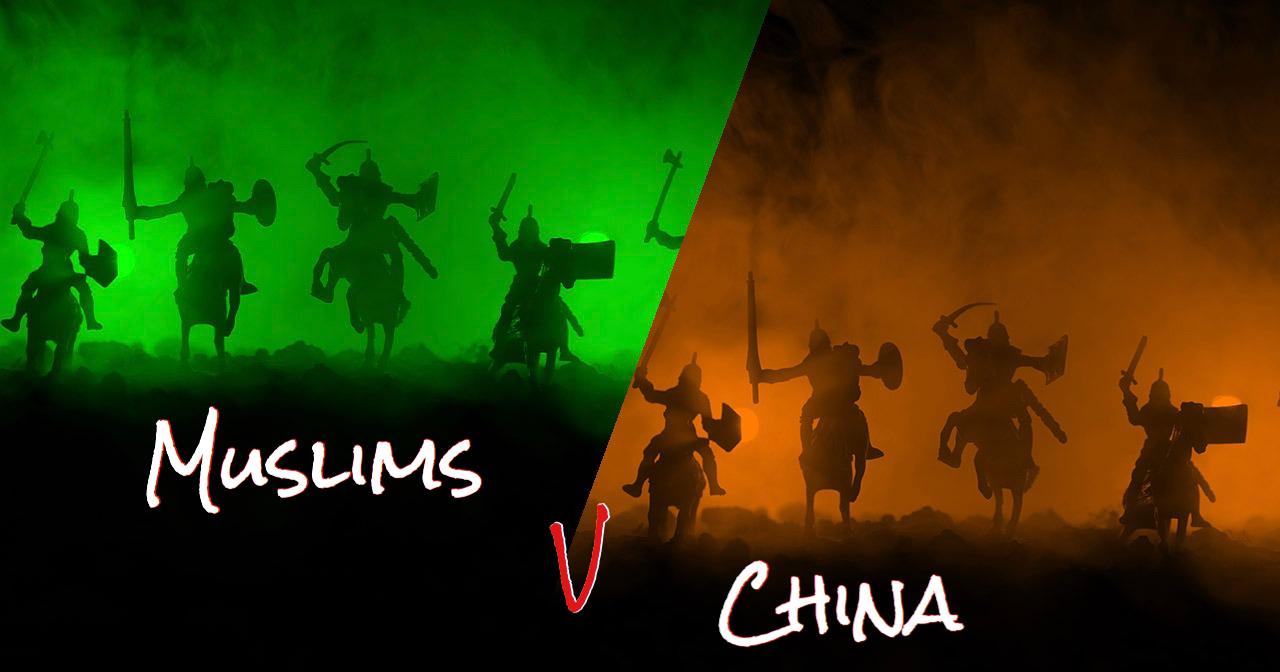“The battle determined the question which of the two civilisations, the Chinese or the Muslim, should predominate in the land (of Turkestan)” [1]
China has been in the public eye in recent times with respect to its mistreatment of minority groups in Hong Kong as well as the Uyghur Muslims of East Turkestan. In addition, they have also received much coverage in view of the country being the first to have been impacted by the pandemic that has gripped the entire world, the coronavirus.
The country is home to one fifth of the world’s population, and is one of the most ancient and established civilisations in the world. It is a country that spans from the Pacific Rim to deep into the heartland of Asia. It houses one of the Seven Wonders of the World, The Great Wall of China, which is so magnificent that it can be seen from outer space. But China houses one treasure that she has kept hidden, greater than everything else – 22 million Muslims (around 1.6% of the total population) with their unique history.
China has only ever fought a Muslim army once, and few people are aware of this battle. The eminent Sinologist, L. Carrington Goodrich, described this battle as: “One of the decisive battles of history” [2] whilst the Russian Orientalist and historian extraordinaire of Muslim Central Asia, Barthold, declared that this battle “Determined the question which of the two civilisations, the Chinese or the Muslim, should predominate in the land (of Turkestan).” Many may wonder how the armies of Islam, whose imperial city in Damascus, came to contend with soldiers from as far east as the Pacific. To answer this, one must understand the early spread of Islam and its forces.
The advent of Islam
Few events in history have had such a swift, profound, and far-reaching impact on the world as the arrival of Islam. Within a mere fifteen years of the Messenger of Allāh’s (sallAllāhu ‘alayhi wasallam) death in 632, the Muslims conquered all the centres of ancient Near Eastern civilisation. They had erased a great and enduring regional power, Persia; reduced its brilliant rival, Byzantium, to a rump state; and carved from their territories an empire as vast as that of Rome at its height. Under the Umayyad Dynasty (661-750), the Muslims soon brought vast areas under their sway. They conquered Spain and Portugal in the west, reaching as far as modern day France – where they were harrying the frontiers of the Merovingian princes – across North Africa and the Middle East and on to the oasis cities of Merv, Tashkent, and Samarkand in Central Asia, right through to the south east to modern day Pakistan, and everything in between. The Muslim conquest spread with breath-taking speed. It was one of the fastest moving irresistible forces in history.
First contact with China
China’s first contact with Islam and Muslims is believed to have been during the khilāfah (Caliphate) of Uthmān (radiyAllāhu ‘anhu), when it was said that he sent a group of envoys under the leadership of Sa’d ibn Abī Waqqās, the great sahābī of the Messenger of Allāh (sallAllāhu ‘alayhi wasallam). He was a relative of the Messenger of Allāh (sallAllāhu ‘alayhi wasallam) through his mother, and is often referred to as the Prophet’s uncle. He was a great commander of the Muslim army during the famous battle of Qādisiyah, and was one of blessed ten guaranteed paradise – al-`Ashara al-Mubashara. Sa’d and a number of companions travelled to meet Emperor Gaozong of the Tang Dynasty in 651. Shortly after this visit, it was stated that the first mosque was built in the southern trading port of Guangzhou, making it one of the world’s oldest mosques [3].
The Tang Dynasty
The Tang dynasty was an imperial dynasty of China that ruled from 618 – 907, establishing one of the largest territories in Chinese history. By the mid-eighth century, they were one of the major players in Euroasia, extending their power as far as contemporary Afghanistan. This was, however, the furthest a Chinese power would ever go. They faced many challenges, as they were surrounded by a number of strong and competing forces: to the East there were the Koreans; in the North there were the Khitans the Uyghurs and other Turkish confederations – none of whom were Muslim at this time – and to the South, there was the new and emerging Tibetan Empire.
The Muslim army’s entrance into Central Asia
The Muslims crossed into Transoxania, known in Arabic sources as Mā Warāʾ al-Nahr (corresponding approximately with modern-day Uzbekistan, Tajikistan, southern Kyrgyzstan, and southwest Kazakhstan), in 654 under the Umayyad campaign led by Qutayba bin Muslim al‐Bahili (d 715) by orders of the infamous Muslim governor, Hajjāj b. Yūsuf. Qutayba defeated the Sassanian and took over Khurasan where he was made the governor. This proved to be a great success for the Muslims, given that within the next decade or so, Qutayba led a number of charges in to Central Asia, subduing most of it and bringing new territory into the realms of the lands of Islam, including Bukhāra, the Ferghana Valley, and as far east as Kashgar (which on the Chinese/Kyrgyz border today). China themselves were making moves in Central Asia. This only meant one thing – they were on a collision course with the Muslims.
The battle with China
Whilst Qutayba subdued most of Central Asia, petty kings and princes continued to send embassies to China, receiving titles of honour from the reigning Tang emperor, Hsuan-tsung. It was these competing petty kings who would in fact draw the world of Islam against that of China, as they were allied to either side. In actual effect, the two competing powers were not looking for an out-and-out conflict, but as is often the case when acting as a protectorate for tributary states, it can lead into unchartered territory and conflicts not previously considered. That is exactly what happened here.
The King of Fergana (Eastern Uzbekistan today) sought assistance from China concerning its dispute with the King of Kucha (modern day East Turkestan/Xinjiang, the area home to the Uyghur Muslims). The Chinese forces were led by a famous commander of Korean ethnicity, Kao Hsien-chih, whose forces in 750 killed the King of Kucha. His son, however, managed to escape and in turn sought assistance from the Muslims. The Muslims were now no longer under the rule of the Umayyads, whose rule came to an abrupt end in 750. They were replaced by the Abbasids, whose first Caliph was Abū al-‘Abbās al-Saffah.
The Abbasid governor of the area once controlled by Qutayba was now Abū Muslim al-Khurasānī (d. 755), who played a prominent role in the establishment of the Abbasids. At the request of the son of the fallen King of Kucha, Abū Muslim quickly gathered an army at Merv (in today’s Turkmenistan, which was incidentally the first city to fall to the Abbasids during their revolt against the Umayyads). He added reinforcements from Tukharistan (a province in the north of today’s Afghanistan) and crossed the Oxus to march to Samarkand. There, he joined the army of Transoxania under Ziyād ibn Sālih, formerly the Umayyad governor of Kufa, Iraq. Ziyād then took overall command of the army. Abū Muslim had entrusted the army to Ziyād, who much like the Korean general of the Chinese army had made a name for himself as a fine commander.
The Chinese had gathered an army of 30,000 according to Chinese sources, and 100,000 according to Muslim sources [4]. The actual account is likely to be somewhere between those respective accounts. The Muslim army was likely to be of equal number. The Chinese met the armies of Islam at the banks of the Talas River (an area bordering modern day Kyrgyzstan and Kazakhstan) in the summer of 751, which is why the encounter has come to be known as the ‘Battle of Talas’.
As per custom, Ziyad made his ablution on the morning of battle, and after performing the morning fajr prayer, he set off at sunlight to meet enemy forces. Both armies stood in battle formation with their armoured horses, cavalry with spears and javelins, and footmen with bows and swords. The battle began in earnest and was hard fought. It continued for five days with no party giving a quarter to the other. The Chinese army were accompanied by a group of Karluks, who were a prominent nomadic Turkic tribal confederacy residing in the regions to the north of the Tang dynasty. The Karluks proved to be decisive; midway through the battle, they sided with the Muslims as part of a pre-arranged plan with the astute Muslim commander, Ziyād. As a result, their cavalry dealt a crushing blow to the Chinese. It was well known that the Turks had the fastest bowmen in Asia at this time. The Turkish Karluk cavalry opened a gaping hole from the side of the Chinese forces and Ziyad, recognising the opportunity that had been presented, did not disappoint in completely destroying the Chinese army. In the in the words of the great Muslim historian and hadith scholar, al-Dhahabi:
“God cast terror into the hearts of the Chinese. Victory descended, and the unbelievers were put to flight.” [5]
Thousands were taken as prisoners. When Ziyad presented himself to Abū Muslim, the latter congratulated him on the glorious victory and honoured him with words of praise saying:
“This is the end of the Chinese army. Now will the law of the Prophet prevail over this vast land, from Arabia to the wall of China itself.” [5]
https://archive.aramcoworld.com/issue/196402/samarkand.751.a.d.htm
Conclusion
There are certain historical battles that have very little immediate influence but over the course of years, decades, or even centuries, demonstrate a tremendous impact. The battle of Talas between the Abbasid Caliphate and the Chinese Tang Empire in 751 is an apt example of such a battle.
For the Tang Dynasty, matters that took place here were overshadowed by events four years later, when an internal revolt erupted known as the ‘An Lushan Rebellion’ lasting some eight years. The rebellion had a devastating impact on the Dynasty and as a result, they did not venture westwards again. They were also be beset with loss of territory to the Tibetans. In the years ahead, the Tibetans and Uyghurs filled the void left by the once great Tang Dynasty, which itself would go on to survive for another 150 years.
Although the Muslims would also not venture further into China, the battle was indeed profitable. Where Central Asia had once been a thoroughfare for Buddhism, the religious dynamics changed following the battle, leading to strong Muslim influence in the region. It would take the best part of another two hundred years before the strong, inherent appeal of Islam fully won the battle of hearts and minds and the people willingly accepted Islam as their religion. This indelibly changed the course of this region forever. It was also crucial in changing the faith of the Turkic tribes who would go on to be exported and form numerous dynasties all across the Muslim world, such as the Tulunid (868-905) and Ikhshdid (935-969) in Egypt; the Ghaznavids of Afghanistan and Punjab (962-1186); and the Mamluks (1250-1517). The most prominent of these were of course the Seljuks (1060-1307), who propped up the Abbasids and could be considered as the forerunners to the Ottomans. There were also a number of famous Turkic beyliks, ghazis, and atabegs, including the famous Zengid dynasty with great Muslim leaders such as Imād-addīn and his son, Nūr-addīn, the one who made Salāh-addīn’s liberation of Al-Aqsa possible. These Turks would go on to play a crucial role in shouldering the responsibility of the Mujāhidīn – the defenders of the faith – and would come to be known as the Ghiyāth al-Muslimīn – saviours of the Muslims.
There was another added benefit from this battle – a prize perhaps more valuable than any plunder. It is said that amongst the thousands of prisoners the Muslims took, there were notable craftsmen who would be instrumental in transmitting a key invention from China to the Muslim world, which in turn was introduced to the Western world. This, of course, was the art of paper making, a technology that would alter world history forever. The invention of paper allowed for the spread of literature and written culture, without which the Renaissance in the West and awakening from its dark age would not have been possible.
It is interesting that the events that led to the Battle of Talas saw the people of Kucha, modern day East Turkestan, sought the assistance of the Muslims. Today, the land of East Turkestan, which is inhabited by Uyghurs, is once again seeking the assistance of the Muslims. However, there is no equivalent to the Abbasid Caliphate to come to their aid. China is in a far stronger position than the Muslim world today. However, we only have to remember the astonishing and miraculous speed with which the newly formed Muslim army conquered all before them catching their opponents by surprise – they were strangers to the established household names who they were challenging. It would therefore not be strange to see such a feat being repeated once again, insha Allāh for indeed, the Messenger of Allāh said:
“Indeed, Islam began as something strange, and it will return to being strange just as it began, so glad tidings of paradise be for the strangers.”[6]
[donationbanner]
Source: www.islam21c.com
Notes:
[1] Turkestan Down to the Mongol Invasion, W. Barthold
[2] A Short History of the Chinese People, L. Carrington Goodrich
[3] China’s Earliest Mosques – Journal of the Society of Architectural Historians, Steinhardt, Nancy Shatzman
[4] Al-Kamil fi al-Tarikh (The Complete History), Ibn Athir
[5] Tarikh al-Islam al-kabir (Great History of Islam), al-Dhahabi
[6] Muslim










Which is the best and true book on Islamic History from 570 to 1940?
Jazakullah.